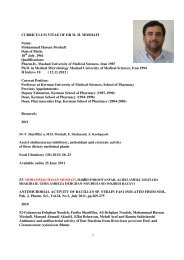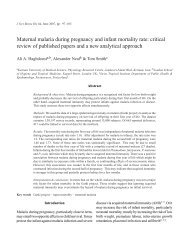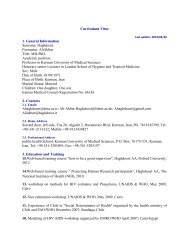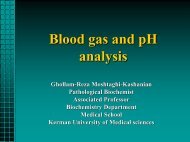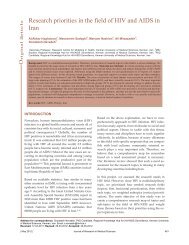How to Write the Methods Section of a Research Paper
How to Write the Methods Section of a Research Paper
How to Write the Methods Section of a Research Paper
You also want an ePaper? Increase the reach of your titles
YUMPU automatically turns print PDFs into web optimized ePapers that Google loves.
<strong>How</strong> <strong>to</strong> <strong>Write</strong> <strong>the</strong> <strong>Methods</strong> <strong>Section</strong> <strong>of</strong> a <strong>Research</strong> <strong>Paper</strong><br />
Richard H Kallet MSc RRT FAARC<br />
Introduction<br />
Basic <strong>Research</strong> Concepts<br />
Content and Writing Style <strong>of</strong> <strong>the</strong> <strong>Methods</strong> <strong>Section</strong><br />
Subjects<br />
Ethical Considerations<br />
Preparations<br />
Pro<strong>to</strong>col Design<br />
Measurements and Calculations<br />
Data Analysis<br />
Summary<br />
The methods section <strong>of</strong> a research paper provides <strong>the</strong> information by which a study’s validity is judged.<br />
Therefore, it requires a clear and precise description <strong>of</strong> how an experiment was done, and <strong>the</strong> rationale<br />
for why specific experimental procedures were chosen. The methods section should describe what was<br />
done <strong>to</strong> answer <strong>the</strong> research question, describe how it was done, justify <strong>the</strong> experimental design, and<br />
explain how <strong>the</strong> results were analyzed. Scientific writing is direct and orderly. Therefore, <strong>the</strong><br />
methods section structure should: describe <strong>the</strong> materials used in <strong>the</strong> study, explain how <strong>the</strong><br />
materials were prepared for <strong>the</strong> study, describe <strong>the</strong> research pro<strong>to</strong>col, explain how measurements<br />
were made and what calculations were performed, and state which statistical tests were<br />
done <strong>to</strong> analyze <strong>the</strong> data. Once all elements <strong>of</strong> <strong>the</strong> methods section are written, subsequent<br />
drafts should focus on how <strong>to</strong> present those elements as clearly and logically as possibly. The<br />
description <strong>of</strong> preparations, measurements, and <strong>the</strong> pro<strong>to</strong>col should be organized chronologically.<br />
For clarity, when a large amount <strong>of</strong> detail must be presented, information should be<br />
presented in sub-sections according <strong>to</strong> <strong>to</strong>pic. Material in each section should be organized by<br />
<strong>to</strong>pic from most <strong>to</strong> least important. Key words: publications; research; research methodology;<br />
clinical trials; labora<strong>to</strong>ry research; writing; mauscripts, medical. [Respir Care 2004;49(10):1229–1232.<br />
© 2004 Daedalus Enterprises]<br />
Introduction<br />
The methods section is <strong>the</strong> most important aspect <strong>of</strong> a<br />
research paper because it provides <strong>the</strong> information by which<br />
Richard H Kallet MSc RRT FAARC is affiliated with <strong>the</strong> Cardiovascular<br />
<strong>Research</strong> Institute, and with Respira<strong>to</strong>ry Care Services, Department <strong>of</strong><br />
Anes<strong>the</strong>sia, San Francisco General Hospital, University <strong>of</strong> California,<br />
San Francisco, California.<br />
Richard H Kallet MS RRT FAARC presented a version <strong>of</strong> this article at<br />
<strong>the</strong> RESPIRATORY CARE Journal symposium, “Ana<strong>to</strong>my <strong>of</strong> a <strong>Research</strong><br />
<strong>Paper</strong>: Science Writing 101,” at <strong>the</strong> 48th International Respira<strong>to</strong>ry Congress,<br />
held Oc<strong>to</strong>ber 5–8, 2002, in Tampa, Florida.<br />
<strong>the</strong> validity <strong>of</strong> a study is ultimately judged. Therefore, <strong>the</strong><br />
author must provide a clear and precise description <strong>of</strong> how<br />
an experiment was done, and <strong>the</strong> rationale for <strong>the</strong> specific<br />
experimental procedures chosen. It must be written with<br />
enough information so that: (1) <strong>the</strong> experiment could be<br />
repeated by o<strong>the</strong>rs <strong>to</strong> evaluate whe<strong>the</strong>r <strong>the</strong> results are reproducible,<br />
and (2) <strong>the</strong> audience can judge whe<strong>the</strong>r <strong>the</strong><br />
results and conclusions are valid. In this article I describe<br />
Correspondence: Richard H Kallet MS RRT FAARC, Respira<strong>to</strong>ry Care<br />
Services, San Francisco General Hospital, NH:GA-2, 1001 Potrero Avenue,<br />
San Francisco CA. 94110. E-mail: rkallet@sfghsom.ucsf.edu.<br />
RESPIRATORY CARE • OCTOBER 2004 VOL 49 NO 10 1229
HOW TO WRITE THE METHODS SECTION OF A RESEARCH PAPER<br />
one approach <strong>to</strong> writing <strong>the</strong> methods section. Because this<br />
section is so intimately related <strong>to</strong> <strong>the</strong> principles <strong>of</strong> scientific<br />
research, I begin with a review <strong>of</strong> basic research<br />
concepts, and <strong>the</strong>n follow with a discussion <strong>of</strong> important<br />
points <strong>to</strong> incorporate when writing <strong>the</strong> methods section.<br />
Basic <strong>Research</strong> Concepts<br />
The scientific method attempts <strong>to</strong> discover cause-andeffect<br />
relationships between objects (ie, physical matter or<br />
processes). In <strong>the</strong> physical sciences objects are regarded as<br />
variables, and a variable is anything that can assume different<br />
values. Elucidating a cause-and-effect relationship<br />
between objects requires that variables are classified as<br />
independent, dependent, or confounding. An independent<br />
variable is one that, when manipulated, causes a change in<br />
ano<strong>the</strong>r variable. The variable that changes in response <strong>to</strong><br />
that manipulation is referred <strong>to</strong> as a dependent variable.<br />
For example, arterial oxygen tension is a dependent variable<br />
that responds <strong>to</strong> manipulations in independent variables<br />
such as barometric pressure and oxygen concentration.<br />
A confounding or extraneous variable is anything<br />
o<strong>the</strong>r than <strong>the</strong> independent variable <strong>of</strong> interest that may<br />
affect <strong>the</strong> dependent variable. Therefore, a change in a<br />
dependent variable may be due wholly or in part <strong>to</strong> a<br />
change in a confounding variable. For example, a change<br />
in minute ventilation can alter arterial oxygen tension by<br />
its effect upon alveolar carbon dioxide partial pressure.<br />
Evaluation <strong>of</strong> a potential cause-effect relationship between<br />
2 objects is accomplished through <strong>the</strong> development<br />
<strong>of</strong> <strong>the</strong> study design. A study design is simply a strategy <strong>to</strong><br />
control and manipulate variables that provide an answer <strong>to</strong><br />
<strong>the</strong> research question regarding potential cause-and-effect<br />
relationships.<br />
Validity refers <strong>to</strong> <strong>the</strong> credibility <strong>of</strong> experimental results<br />
and <strong>the</strong> degree <strong>to</strong> which <strong>the</strong> results can be applied <strong>to</strong> <strong>the</strong><br />
general population <strong>of</strong> interest. Internal validity refers <strong>to</strong><br />
<strong>the</strong> credibility <strong>of</strong> a study and is determined by <strong>the</strong> degree<br />
<strong>to</strong> which conclusions drawn from an experiment correctly<br />
describe what actually transpired during <strong>the</strong> study. 1 External<br />
validity refers <strong>to</strong> whe<strong>the</strong>r (and <strong>to</strong> what degree) <strong>the</strong><br />
results <strong>of</strong> a study can be generalized <strong>to</strong> a larger population.<br />
1 Unfortunately, all biological systems are pr<strong>of</strong>oundly<br />
complex, so simple, unambiguous, direct relationships between<br />
objects can be difficult <strong>to</strong> ascertain. The internal<br />
validity <strong>of</strong> a study is judged by <strong>the</strong> degree <strong>to</strong> which its<br />
outcomes can be attributed <strong>to</strong> manipulation <strong>of</strong> independent<br />
variables and not <strong>to</strong> <strong>the</strong> effects <strong>of</strong> confounding variables.<br />
Therefore, <strong>the</strong> study pro<strong>to</strong>col must be designed <strong>to</strong> control<br />
(eg, <strong>to</strong> keep constant) as many extraneous fac<strong>to</strong>rs as possible<br />
so that any potential cause-and-effect relationship<br />
between 2 objects can be judged accurately. It is important<br />
<strong>to</strong> emphasize that confounding variables can never be fully<br />
controlled. Fur<strong>the</strong>rmore, <strong>the</strong> influence <strong>of</strong> <strong>the</strong>se variables<br />
may not be fully appreciated by those conducting <strong>the</strong> research.<br />
External validity is primarily determined by how<br />
subjects are selected <strong>to</strong> participate in a study and by <strong>the</strong><br />
use <strong>of</strong> randomization procedures that limit potential bias in<br />
how subjects are assigned <strong>to</strong> treatment groups.<br />
Content and Writing Style <strong>of</strong> <strong>the</strong> <strong>Methods</strong> <strong>Section</strong><br />
His<strong>to</strong>rically, <strong>the</strong> methods section was referred <strong>to</strong> as <strong>the</strong><br />
“materials and methods” <strong>to</strong> emphasize <strong>the</strong> 2 distinct areas<br />
that must be addressed. “Materials” referred <strong>to</strong> what was<br />
examined (eg, humans, animals, tissue preparations) and<br />
also <strong>to</strong> <strong>the</strong> various treatments (eg, drugs, gases) and instruments<br />
(eg, ventila<strong>to</strong>rs) used in <strong>the</strong> study. “<strong>Methods</strong>”<br />
referred <strong>to</strong> how subjects or objects were manipulated <strong>to</strong><br />
answer <strong>the</strong> experimental question, how measurements and<br />
calculations were made, and how <strong>the</strong> data were analyzed.<br />
The complexity <strong>of</strong> scientific inquiry necessitates that<br />
<strong>the</strong> writing <strong>of</strong> <strong>the</strong> methods be clear and orderly <strong>to</strong> avoid<br />
confusion and ambiguity. First, it is usually helpful <strong>to</strong><br />
structure <strong>the</strong> methods section by:<br />
1. Describing <strong>the</strong> materials used in <strong>the</strong> study<br />
2. Explaining how <strong>the</strong> materials were prepared<br />
3. Describing <strong>the</strong> research pro<strong>to</strong>col<br />
4. Explaining how measurements were made and what<br />
calculations were performed<br />
5. Stating which statistical tests were done <strong>to</strong> analyze<br />
<strong>the</strong> data 2<br />
Second, <strong>the</strong> writing should be direct and precise and in<br />
<strong>the</strong> past tense. Compound sentence structures should be<br />
avoided, as well as descriptions <strong>of</strong> unimportant details.<br />
Once all elements <strong>of</strong> <strong>the</strong> methods section are written down<br />
during <strong>the</strong> initial draft, subsequent drafts should focus on<br />
how <strong>to</strong> present those elements as clearly and logically as<br />
possibly. In general, <strong>the</strong> description <strong>of</strong> preparations, measurements,<br />
and <strong>the</strong> pro<strong>to</strong>col should be organized chronologically.<br />
For clarity, when a large amount <strong>of</strong> detail must<br />
be presented, information should be presented in subsections<br />
according <strong>to</strong> <strong>to</strong>pic. Within each section and subsection,<br />
material should always be organized by <strong>to</strong>pic from<br />
most <strong>to</strong> least important.<br />
Subjects<br />
Judging <strong>the</strong> external validity <strong>of</strong> a study involving human<br />
subjects (ie, <strong>to</strong> whom <strong>the</strong> study results may be applied)<br />
requires that descriptive data be provided regarding<br />
<strong>the</strong> basic demographic pr<strong>of</strong>ile <strong>of</strong> <strong>the</strong> sample population,<br />
including age, gender, and possibly <strong>the</strong> racial composition<br />
<strong>of</strong> <strong>the</strong> sample. When animals are <strong>the</strong> subjects <strong>of</strong> a study, it<br />
is important <strong>to</strong> list species, weight, strain, sex, and age.<br />
1230 RESPIRATORY CARE • OCTOBER 2004 VOL 49 NO 10
Who is chosen for inclusion in a study (as well as how<br />
treatments are assigned) in large measure determines what<br />
limits are placed on <strong>the</strong> generalizations that can be made<br />
regarding <strong>the</strong> study results. Thus, when writing <strong>the</strong> methods<br />
section, it is important <strong>to</strong> describe who <strong>the</strong> subjects<br />
were in <strong>the</strong> context <strong>of</strong> <strong>the</strong> research question. The selection<br />
criteria and rationale for enrolling patients in<strong>to</strong> <strong>the</strong> study<br />
must be stated explicitly. For example, if <strong>the</strong> study proclaims<br />
<strong>to</strong> examine whe<strong>the</strong>r noninvasive ventilation reduces<br />
<strong>the</strong> need for intubation <strong>of</strong> patients with cardiogenic pulmonary<br />
edema, <strong>the</strong>n one would not anticipate that surgical<br />
patients with respira<strong>to</strong>ry failure would be recruited.<br />
In addition, it is important when describing patients <strong>to</strong><br />
provide some evaluation <strong>of</strong> <strong>the</strong>ir health status that is relevant<br />
<strong>to</strong> <strong>the</strong> study. For example, when examining <strong>the</strong>rapies<br />
that may impact mortality in acutely ill patients, <strong>the</strong> study<br />
subjects’ health status can be assessed with a scoring system<br />
such as <strong>the</strong> Simplified Acute Physiology Score. 3 If<br />
studying patients in a rehabilitation setting, <strong>the</strong>n a general<br />
quality-<strong>of</strong>-life questionnaire such as <strong>the</strong> Sickness Impact<br />
Pr<strong>of</strong>ile can be used. 4<br />
Ethical Considerations<br />
When working with human or animal subjects, <strong>the</strong>re<br />
must be a declaration that <strong>the</strong> medical center’s institutional<br />
review board governing research on living matter has determined<br />
that <strong>the</strong> study pro<strong>to</strong>col adheres <strong>to</strong> ethical principles.<br />
Without such approval, no research project can be<br />
conducted nor can it be published in a reputable, peerreview<br />
science journal.<br />
Preparations<br />
HOW TO WRITE THE METHODS SECTION OF A RESEARCH PAPER<br />
In studies involving animal models or mechanical models,<br />
a detailed description must be provided regarding <strong>the</strong><br />
preparations made prior <strong>to</strong> beginning <strong>the</strong> experimental pro<strong>to</strong>col.<br />
In studies involving animals a detailed description<br />
should be provided on <strong>the</strong> use <strong>of</strong> sedation and anes<strong>the</strong>sia,<br />
<strong>the</strong> route <strong>of</strong> administration, and how its efficacy was evaluated.<br />
2 In addition, all aspects <strong>of</strong> animal or tissue preparation<br />
required prior <strong>to</strong> initiation <strong>of</strong> <strong>the</strong> research pro<strong>to</strong>col<br />
must be described in detail. With any animal preparation<br />
or mechanical model <strong>the</strong>re must be enough detail provided<br />
so that <strong>the</strong> reader can duplicate it or evaluate its relevance.<br />
When a study involves <strong>the</strong> use or evaluation <strong>of</strong> drugs, <strong>the</strong><br />
generic drug name should be used and <strong>the</strong> manufacturer,<br />
concentration, dose, and infusion rate should be specified.<br />
Likewise, when medical gases are used, <strong>the</strong> concentration<br />
and flow rates should be specified.<br />
It is worth noting that <strong>the</strong> introduction <strong>of</strong> any novel<br />
method for measuring a variable, or preparing/designing a<br />
model will require intense discussion. Depending on how<br />
unique (or unorthodox) <strong>the</strong> new method is, its validation<br />
probably should be established in a separate publication,<br />
published prior <strong>to</strong> submission <strong>of</strong> <strong>the</strong> main study.<br />
Pro<strong>to</strong>col Design<br />
The research pro<strong>to</strong>col is <strong>the</strong> sequence <strong>of</strong> manipulations<br />
and measurement procedures that make up <strong>the</strong> experiment.<br />
Its description should follow <strong>the</strong> exact sequence <strong>of</strong> how<br />
<strong>the</strong> procedures were executed. 2 Typically, this first involves<br />
a description <strong>of</strong> baseline conditions and any associated<br />
baseline measurements, followed by <strong>the</strong> sequence<br />
<strong>of</strong> manipulations <strong>of</strong> <strong>the</strong> independent variable and <strong>the</strong> subsequent<br />
measurement <strong>of</strong> changes in <strong>the</strong> dependent variable.<br />
It is also important <strong>to</strong> describe all relevant aspects <strong>of</strong><br />
clinical management not controlled by <strong>the</strong> pro<strong>to</strong>col in <strong>the</strong><br />
peri-experimental period.<br />
When writing <strong>the</strong> methods section, it is important <strong>to</strong><br />
bear in mind that <strong>the</strong> rationale or assumptions on which<br />
some procedures are based may not always be obvious <strong>to</strong><br />
<strong>the</strong> audience. This is particularly true when writing for a<br />
general medical audience, as opposed <strong>to</strong> members <strong>of</strong> a<br />
subspecialty. Therefore, <strong>the</strong> writer must always keep in<br />
mind who his/her audience is. The rationale and assumptions<br />
on which experimental procedures are based should<br />
be briefly stated in <strong>the</strong> methods section and, if necessary,<br />
described in more detail in <strong>the</strong> discussion section. Whenever<br />
it is not obvious, <strong>the</strong> purpose <strong>of</strong> a procedure should be<br />
stated in relationship ei<strong>the</strong>r <strong>to</strong> <strong>the</strong> research question or <strong>to</strong><br />
<strong>the</strong> entire pro<strong>to</strong>col. Writing <strong>the</strong> methods section in this<br />
style is called a purpose-procedure format. 2<br />
Measurements and Calculations<br />
The next step in <strong>the</strong> methods section is <strong>to</strong> describe what<br />
variables were measured and how those measurements were<br />
made. The description <strong>of</strong> measurement instruments should<br />
include <strong>the</strong> manufacturer and model, calibration procedures,<br />
and how measurements were made. It also may be<br />
necessary <strong>to</strong> justify why and how certain variables were<br />
measured. This becomes particularly important when <strong>the</strong><br />
object <strong>of</strong> <strong>the</strong> experiment can be approached only indirectly.<br />
Tangentially, whenever a value for a variable is<br />
used <strong>to</strong> signify a state or condition, this should be stated<br />
explicitly. For example, one could state: “Adequate intravascular<br />
volume status was indicated by a central venous<br />
pressure <strong>of</strong> � 8mmHg.” A listing <strong>of</strong> all calculations used<br />
in <strong>the</strong> study typically follows <strong>the</strong> description <strong>of</strong> measurements.<br />
Data Analysis<br />
The last step in <strong>the</strong> methods section is <strong>to</strong> describe how<br />
<strong>the</strong> data will be presented in <strong>the</strong> results section (eg, mean<br />
vs median), which statistical tests will used for <strong>the</strong> infer-<br />
RESPIRATORY CARE • OCTOBER 2004 VOL 49 NO 10 1231
HOW TO WRITE THE METHODS SECTION OF A RESEARCH PAPER<br />
ential data, and what p value is deemed <strong>to</strong> indicate a statistically<br />
significant difference.<br />
Summary<br />
The methods section is <strong>the</strong> most important part <strong>of</strong> a<br />
research paper because it provides <strong>the</strong> information <strong>the</strong><br />
reader needs <strong>to</strong> judge <strong>the</strong> study’s validity. Providing a<br />
clear and precise description <strong>of</strong> how an experiment was<br />
done, and <strong>the</strong> rationale for specific experimental procedures<br />
are crucial aspects <strong>of</strong> scientific writing.<br />
REFERENCES<br />
1. Hulley SB, Newman TB, Cummings SR. The ana<strong>to</strong>my and physiology<br />
<strong>of</strong> research. In: Hulley SB, Cummings SR (edi<strong>to</strong>rs). Designing<br />
clinical research. Baltimore: William & Wilkins; 1988:1–11.<br />
2. Zeiger M. Essentials <strong>of</strong> writing biomedical research papers. New<br />
York: McGraw-Hill; 1991:113–138.<br />
3. Le Gall JR, Lemeshow S, Saulnier F. A new Simplified Acute Physiology<br />
Score (SAPS II) based on a European/North American multicenter<br />
study. JAMA 1993;270(24):2957–2963.<br />
4. Bergner M, Bobbitt RA, Carter WB, Gilson BS. The Sickness Impact<br />
Pr<strong>of</strong>ile: development and final revision <strong>of</strong> a health status measure.<br />
Med Care 1981;19(8):787–805.<br />
1232 RESPIRATORY CARE • OCTOBER 2004 VOL 49 NO 10



